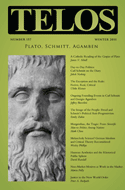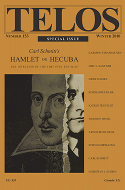By James V. Schall · Tuesday, January 24, 2012 James V. Schall’s “A Catholic Reading of the Gorgias of Plato” appears in Telos 157 (Winter 2011). Read the full version online at the TELOS Online website, or purchase a print copy of the issue here.
 The Gorgias of Plato is of particular interest to political philosophy. Not only is there a detailed discussion of punishment and oratory, but also of practical political ways of action and their foundation. This dialogue is of particular worth for the Roman Catholic notion of the relation of reason and revelation. Political life leaves us with the notion that not all crimes are punished, nor are all good deeds rewarded. This fact leaves the Platonic concern of whether the world is created in injustice. The myth at the end of the Gorgias suggests that politicians are the ones most likely to cause extensive damage and evil in the world. It also argues that unless such deeds are suffered for, thus righting the principle, they will be punished. This consideration naturally leads to the issue of resurrection, an issue about which even Marxist-oriented philosophers like Adorno and Horkheimer saw the logic. The Gorgias of Plato is of particular interest to political philosophy. Not only is there a detailed discussion of punishment and oratory, but also of practical political ways of action and their foundation. This dialogue is of particular worth for the Roman Catholic notion of the relation of reason and revelation. Political life leaves us with the notion that not all crimes are punished, nor are all good deeds rewarded. This fact leaves the Platonic concern of whether the world is created in injustice. The myth at the end of the Gorgias suggests that politicians are the ones most likely to cause extensive damage and evil in the world. It also argues that unless such deeds are suffered for, thus righting the principle, they will be punished. This consideration naturally leads to the issue of resurrection, an issue about which even Marxist-oriented philosophers like Adorno and Horkheimer saw the logic.
Continue reading →
By Charles Kollmer · Thursday, January 19, 2012 As an occasional feature on TELOSscope, we highlight a past Telos article whose critical insights continue to illuminate our thinking and challenge our assumptions. Today, Charles Kollmer looks at Stephanie Frank’s “Re-imagining the Public Sphere: Malebranche, Schmitt’s Hamlet, and the Lost Theater of Sovereignty,” from Telos 153 (Winter 2010).

In “Re-imagining the Public Sphere: Malebranche, Schmitt’s Hamlet, and the Lost Theater of Sovereignty,” Stephanie Frank outlines a compelling approach to Carl Schmitt’s complex oeuvre. She sets out to rectify a common mistake made in existing treatments of Schmitt; in studies of Schmitt’s early work Roman Catholicism and Political Form (1923), scholars tend to rely on a later work, Constitutional Theory (1928), as an explanatory crutch. Both texts model representation, but a conflation of their respective models obscures how Schmitt’s project changes between the works. As a corrective, Frank traces the nuances of Roman Catholicism‘s model back to the influence of seventeenth-century theologian Malebranche, who in turn influenced the eighteenth-century revolutionary Abbé Sieyès. By grounding Roman Catholicism in this historical context, Frank not only sidesteps the circularity of her colleagues’ interpretations but also lays the groundwork for a persuasive reading of Schmitt’s turn to aesthetics in Hamlet or Hecuba (1956).
Continue reading →
|
|
 The Gorgias of Plato is of particular interest to political philosophy. Not only is there a detailed discussion of punishment and oratory, but also of practical political ways of action and their foundation. This dialogue is of particular worth for the Roman Catholic notion of the relation of reason and revelation. Political life leaves us with the notion that not all crimes are punished, nor are all good deeds rewarded. This fact leaves the Platonic concern of whether the world is created in injustice. The myth at the end of the Gorgias suggests that politicians are the ones most likely to cause extensive damage and evil in the world. It also argues that unless such deeds are suffered for, thus righting the principle, they will be punished. This consideration naturally leads to the issue of resurrection, an issue about which even Marxist-oriented philosophers like Adorno and Horkheimer saw the logic.
The Gorgias of Plato is of particular interest to political philosophy. Not only is there a detailed discussion of punishment and oratory, but also of practical political ways of action and their foundation. This dialogue is of particular worth for the Roman Catholic notion of the relation of reason and revelation. Political life leaves us with the notion that not all crimes are punished, nor are all good deeds rewarded. This fact leaves the Platonic concern of whether the world is created in injustice. The myth at the end of the Gorgias suggests that politicians are the ones most likely to cause extensive damage and evil in the world. It also argues that unless such deeds are suffered for, thus righting the principle, they will be punished. This consideration naturally leads to the issue of resurrection, an issue about which even Marxist-oriented philosophers like Adorno and Horkheimer saw the logic. 







